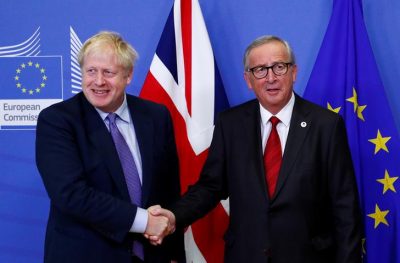Details of new Brexit deal Boris Johnson struck with EU

The European Union has agreed a new Brexit deal with Britain. Here are the initial details.
Northern Ireland
Northern Ireland remains in the United Kingdom’s customs territory but all EU procedures will apply to goods arriving there in this complex system. There will be no customs checks on the island of Ireland – they will be done in ports.
For goods crossing from Great Britain to Northern Ireland that are deemed to be staying there, no EU tariff will apply.
No EU tariffs would be paid on personal goods carried by travellers across the Irish frontier and for a second category of exempted goods that can only be for immediate consumption rather than subsequent processing.
An EU-UK body called the Joint Committee will define this second group of goods more precisely after Brexit.
The UK will be allowed to reimburse excise duties for companies in Northern Ireland as long as it does not undercut EU state aid rules.
Northern Ireland will be able to benefit from future UK trade deals around the world. As long as the goods do not cross to Ireland and the EU’s single market, only UK customs tariffs will apply.
CONSENT
The Northern Irish assembly will have to give consent after Brexit for the region’s continued alignment with the EU regulatory regime.
Four years after Brexit, the assembly will have to decide by simple majority of those taking part in the vote whether to apply it. If the vote is positive, the system is extended for another four years.
If another vote then is positive with cross-community support, the system is extended by another eight years until another vote.
If consent is not granted, there is a two-year cooling off period during which sides need to find a new solution to prevent the return of a hard border on the island of Ireland.
If the regional assembly does not sit or vote, the system continues as the default position.
Unlike the “backstop” solution in the original deal, rejected by the British parliament, this system would not be replaced by a new free-trade deal between Britain and the EU. That marks a big concession from the EU side.
FUTURE TRADE DEAL, LEVEL-PLAYING FIELD
Sides aim at an ambitious free-trade agreement after Brexit with no tariffs and unlimited quotas. It comes together with a statement that sides will uphold high standards on environment, climate, workers’ rights and other rules.
REST REMAINS AS IN PREVIOUS AGREEMENT
Previously agreed settlement on citizens’ rights after Brexit and Britain’s divorce bill stay as they were. That also goes for a transition period of 14 months until the end of 2020, which can be extended by one year or two years.

